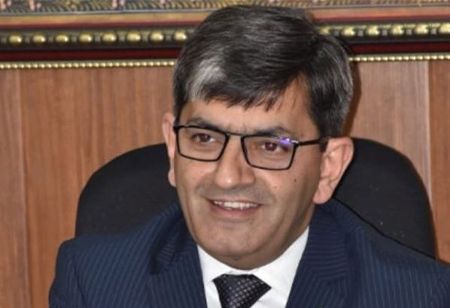Dr. Zabeer Ahmed, Director, CSIR-IIIM Jammu

In the GGSCOP National Conference on Advancing Pharmaceutical Research, Dr. Zabeer Ahmed, Director, CSIR-IIIM Jammu, shares his views on the importance of merging traditional medicinal knowledge with advanced scientific methods and regulatory frameworks. He also pointed out the CSIR Phytopharmaceuticals Mission aims to progress the herbal medicine industry while preserving the rich heritage of the Indian System of Medicine. Following are the key insights from his address.
CSIR–IIIM began its operations in 1941 with a focus on developing natural products from herbal resources and utilized to perform chemical characterization, isolation of molecules, and pharmacological activities. Colonel R. N. Chopra, the person behind the establishment of this research institute, was founded in 1941. It was known as Regeneration Laboratory, and subsequently, it was taken over by the Council of Scientific and Research CSIR–IIM plays a pivotal role in the integration and modernization of traditional medicines.
Regarding the preclinical phase of drug discovery, CSIR–IIIM is a composite model for preclinical drug discovery. CSIR–IIIM is based in the Jammu & Kashmir region where natural products and natural sources are present. The area also has an important component of microbial species and adheres to an end-to-end approach as far as drug discovery programs from natural sources are concerned. Examining the global condition and overall landscape of drug discovery on one side, there is a traditional system of medicine along with natural sources. The presence of natural sources, biodiversity, and infrastructure gives a strong foundation. The endeavor is to position traditional medicines and phytopharmaceuticals in the worldwide market, and this methodology is being practiced at this institution.
With respect to the pharmacological division of this institution, Council of Scientific and Industrial Research–Indian Institute of Integrative Medicine (CSIR–IIIM), there are various areas where this institute works, and the main focus is to evaluate certain New Compounds (NCs) to explore phytopharmaceuticals. From the policy makers' point of view, the research institute should globalize traditional and local knowledge. Phytopharmaceutical drug development was adopted in India, and the main objective of this act is to standardize traditional medicines to perform chemical characterization and do captive cultivations of these conventional plants so that CSIR can place natural resources into India and the global market.
The Phytopharmaceutical Act was enacted and implemented in 2015. When defining a phytopharmaceutical drug within the TDC system, it is imperative to recognize that formulations already exist. Nevertheless, it becomes necessary to adapt and align with changing standards with time. More importantly, standardization is required to introduce traditional medicines and medicinal plant-based products into advanced and global markets.
As per the Phytopharmaceutical Act, any standardized plant extract that is a part of the plant. However, it should have four bioactive or normal phytochemical compounds, such as an allopathic system of medicines and the guidelines for drug discovery. But at the same time, parallel to the allopathic system, this phytopharmaceutical guideline is where CSIR is doing exploration and research, similar to the preclinical drug discovery institute following the allopathic system of medicines.
The main objectives of the CSIR phytopharmaceutical mission are sourcing plant material, captive cultivation of herbal resources, processing, quality control, value additions, and exploratory studies for certain disease targets, ultimately contributing to the development of herbal medicine.
Across India, many labs are involved; CSIR triple IM Jammu is a nodal lab for phytopharmaceutical missions in India. Taking into account the kind of progress CSIR made in phases two and three, they identified two formulations of PAPI preparation, stability studies, and pre-clinical efficacy toxicological studies, which were completed. Regarding phase three, CSIR is putting this formulation for clinical trial, like INDs for these formulations have already been filed. Apart from this, the other crucial area CSIR considers is the cannabis research in the cannabis sativa. Cannabis sativa is a prohibited plant, and CSIR triple IM is the first in the government sector to deliver a lesson to the Jammu and Kashmir government for completing the basic pre-clinical research.
Hence, in two main verticals, CSIR is focusing on phase three of phytopharmaceutical, wherein one is captive cultivation. When discussing the standardization of any part or extract of a plant based on four markers, there is another significant challenge in maintaining the range of the specifically identified four markers. In this, CSIR has identified that in one vertical, the captive cultivations of all shortlisted plants and the plants they are working on, the captive cultivation should be done so that in the future, CSIR will be able to present and demonstrate before the policymaker that such kind of ranges should be adopted as far as standardization of phytopharmaceutical drugs is concerned.
In light of Nutraceutical Compounds, CSIR plans to start with the phase one and two clinical trials for triple IM 290. With the successful completion of all clinical trials, triple IM 290 will be the first molecule from India, which will be used orally to manage pancreatic cancer. So these are a few phytopharmaceutical leads where triple IM, IHBT, and CMAP are doing captive cultivation. CSIR is developing this product as a phytopharmaceutical drug for managing Alzheimer's disease. Pharmenza Herbal is a company that collaborates with CSIR, and they are just developing this phytopharmaceutical for Alzheimer's disease.